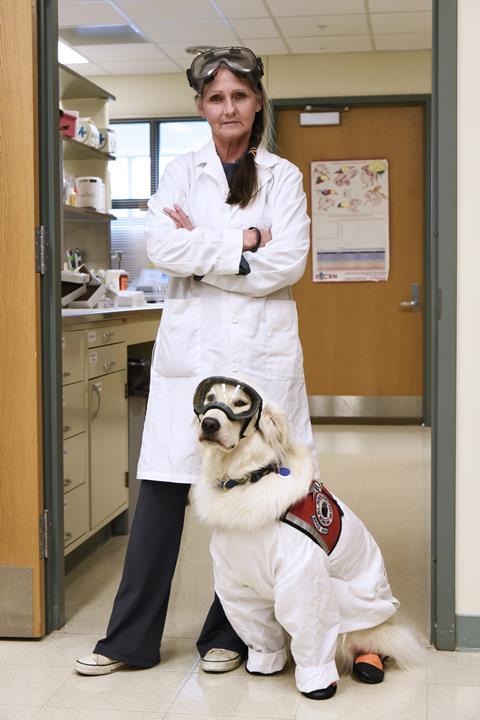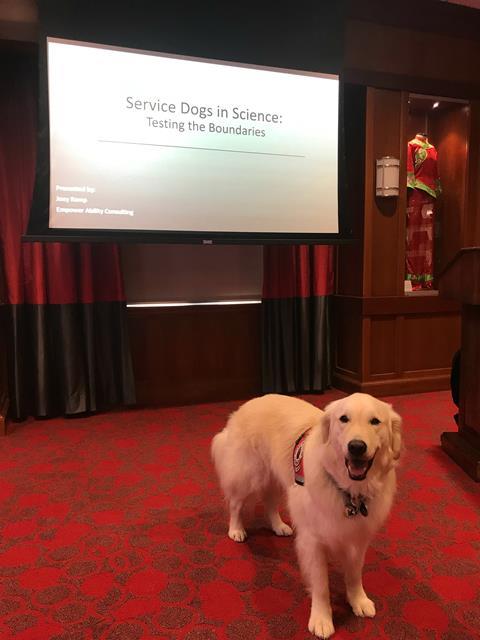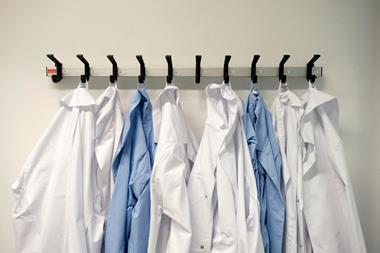Researcher Joey Ramp’s brain injury and nerve damage meant that she needed a service dog in the lab, and roadblocks ended her PhD pursuit

Before former horse trainer Joey Ramp suffered a brain injury and extensive nerve damage to her left side from a polo accident in February 2006, she had never imagined a career in research or in disability rights advocacy. Yet here she is, working to encourage universities and research facilities to develop guidelines for service animals in labs, and shaking up academic science in the process.
Sampson, a white golden retriever, has been Ramp’s partner since 2016. He is her constant companion at home, on hikes and in the molecular cellular neurobiology lab at the University of Illinois in Urbana-Champaign where she works. As her lab assistant, Sampson fully dresses the part – wearing personal protective equipment (PPE) like goggles, a lab coat and even boots.
Ramp began working with Sampson in the summer of 2016, when he was fresh from basic training. She spent about nine months teaching him to be her partner. ‘We had to individualise and personalise him being my service dog, and then also teach him how to wear the PPE and how to behave in a lab,’ Ramp recalls.
Now he helps Ramp navigate the lab. ‘There are days where just moving around the lab is difficult – when I get tired or overstressed that left side gets less responsive, to the point that my foot will drag or my brain says I have taken a step but my left foot didn’t respond,’ she explains. On such days Sampson wears a special leather harness with a handle that Ramp can grip, so that she can use him as a brace and to balance.
Sampson, who has his own Twitter handle, will also come to Ramp’s side so that she can kneel down and retrieve something from the floor of the lab. ‘If he wasn’t there, I would have to ask someone to do those things for me, which would take away my independence,’ she says. But he is trained to never pick anything up without Ramp’s command, which is especially important in a lab environment.
Special science training

In an emergency Sampson can keep her safe by guiding her to an exit. He also performs medical alerts, although a service dog working in a lab cannot warn a partner about a medical issue in the typical way. ‘Most will either nudge their person’s hand or leg, but you don’t want them doing that in a lab because it could potentially startle somebody or cause a spill,’ Ramp explains.
If she is showing signs of becoming overwhelmed by too much stimulation or anxiety – like hand rubbing, a change of voice tone, or a specific breathing pattern – Sampson will sit up and hold in his mouth a ribbon that is attached to his collar.
‘This tells me and my co-workers that something is wrong,’ she explains. ‘What that does for me is it keeps my brain from getting so far overloaded that I can’t come back in that moment.’
Universities generally lack guidelines or policies for animals like Sampson in labs, for example to specify what skills they must master and what type of PPE they should wear. But Ramp is working to change that. ‘My university was the reason I became such an advocate, because I met some serious resistance,’ she says.
After her accident, Ramp grew frustrated that there were so few answers to what was happening in her brain, and decided to go into neuroscience in 2011. She took classes at a local community college first to complete some course prerequisites. There, she was told people with service animals can’t work in labs.
Frustration and roadblocks
In 2015, Ramp transferred to the University of Illinois, which had a reputation as one of the most disabled-friendly schools in the US, to study the neurological underpinnings of post-traumatic stress disorder after brain injury. But things continued to be extremely difficult. It took a year before she got permission to take a required organic chemistry course with Sampson.
Then in early 2017, during what was supposed to be the last semester of her bachelor’s degree, she was blocked from taking a required behavioural neuroscience course. The class involved handling live rodents, and there was concern that a service dog would negatively affect such research animals.
Ramp was eventually prohibited from entering the entire psychology building, though that ruling was reversed after she challenged it. Nevertheless, she was banned from certain floors and specific elevators because of Sampson.
The plan had been for Ramp to work for her advisor after graduation. There was a PhD position available for her to take, but that option disappeared since she couldn’t do the necessary research. Being shut out of the behavioural neuroscience class also meant she couldn’t do her planned research that summer, so Ramp lost a $3000 scholarship. Ultimately, she stopped pursuing her PhD in May 2019.

‘I could have changed my research direction, but that is when I had just started doing all of this advocacy work,’ Ramp recounts. ‘Someone who shows up in a lab with a disability – a wheelchair or other medical assistive device – is not told that they have to leave,’ she states. ‘Yet, those who show up with a service dog that is well trained and credentialled are turned away oftentimes.’
Ramp now sees advocacy as her new calling. She gets enquiries every day from students and faculty all over the world soliciting advice about how to address roadblocks for disabled persons in research, especially pertaining to service animals. She also regularly speaks on the topic to universities in the US and beyond.
‘It is gratifying, and it is good to see positive change,’ Ramp tells Chemistry World. ‘I hope I can change the path that I walked so that it is clearer for others.’












2 readers' comments